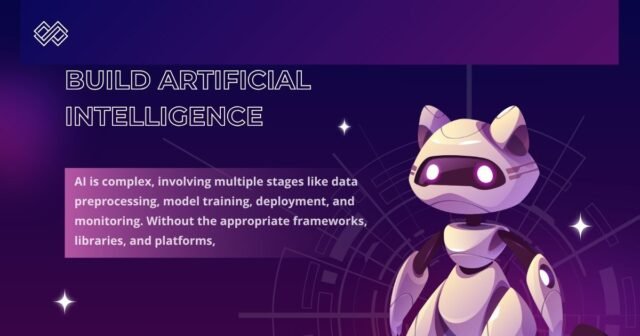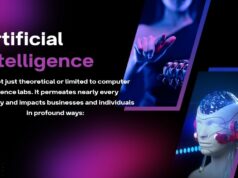Artificial intelligence (AI) has evolved from a future concept to become an integral part of our world. From automation of commercial workflows to cure individual marketing campaigns, the AI applications have been reshaped globally. But how do innovators, researchers and developers create AI systems that can treat, learn and perform complex tasks? The answer lies in taking advantage of the right equipment.
This blog examines the best devices for creating artificial intelligence, discussing their purposes, functionality and why they are necessary to prepare successful AI solutions.
Why Choosing the Right AI Tools Matters
Before we jump into the details, it is worth emphasizing the importance of choosing the right tool for the production of AI. Developing AI is composed, which includes several stages such as data preparation, model training, distribution and monitoring. Navigation of these stages can be disabled, time -consuming and expensive, without appropriate structures, libraries and platforms.
Choosing the right equipment ensures scalability, accuracy and efficiency, enabling the production of AI systems that meet the needs of modern business.
Now let’s find out the top devices to do AI and make them inevitable.
Best Tools for Building Artificial Intelligence
TensorFlow
Purpose: Open-source machine learning (ML) and deep learning framework
TensorFlow, developed by Google Brain, is one of the most widely used frameworks for machine learning and AI development. Its versatility makes it suitable for tasks ranging from neural network implementation to deploying AI models on mobile and edge devices.
Key Features:
- Scalability: TensorFlow supports both small-scale experiments and large-scale production systems.
- Easy Deployment: Deploy models anywhere, from servers to smartphones.
- Robust Community Support: Benefit from extensive online resources, tutorials, and ready-to-use models.
Best For: Developers looking to build robust, scalable AI solutions across industries such as healthcare, e-commerce, and fintech.
PyTorch
Purpose: Dynamic machine learning framework
Created by Facebook, PyTorch is renowned for its flexibility and ease of use. Its dynamic computation graph feature allows researchers to make on-the-fly changes to the neural network architecture, a benefit for experimentation and innovation.
Key Features:
- Dynamic Computation Graphs: Perfect for research and development.
- User-Friendly: Simplified syntax that caters to both beginners and experts.
- Integration with Python: Seamlessly works with the Python ecosystem.
Best For: Researchers and developers focusing on deep learning models or academic use cases.
Jupyter Notebook
Purpose: Interactive development environment
AI development involves experimentation with algorithms and data workflows, making Jupyter Notebook a developer favorite. It’s an open-source platform that creates an interactive space for coding, visualizing, and documenting your AI projects.
Key Features:
- Interactive Coding: Run code, visualize outputs, and debug in real-time.
- Multi-language Support: Works with Python, R, and more.
- Integration-Friendly: Compatible with data science and ML libraries like NumPy and Matplotlib.
Best For: Data scientists and developers who need a flexible, interactive coding environment for experimenting and collaboration.
OpenCV
Purpose: Computer vision library
When it comes to developing AI systems capable of handling visual data, OpenCV (Open Source Computer Vision Library) is the go-to tool. Its practical applications range from facial recognition to object detection and augmented reality.
Key Features:
- Real-time Image Processing: Handles videos and images incredibly efficiently.
- Extensive Functionality: Includes tools for image and video analysis.
- Widespread Compatibility: Works across multiple platforms and supports several programming languages.
Best For: Computer vision projects, including AI applications in retail (e.g., automated checkouts) or security systems.
Keras
Purpose: User-friendly deep learning framework
Keras, built on top of TensorFlow, simplifies the process of building deep learning models. It’s ideal for those starting out in AI as well as seasoned developers who want a high-level abstraction layer to manage complex neural networks.
Key Features:
- Ease of Use: Intuitive APIs for quick prototyping.
- Modularity: Highly flexible backend integration.
- Extensive Pre-trained Models: Get a head start with ready-made solutions.
Best For: Beginners in AI development and developers who want efficient deployment pipelines.
IBM Watson
Purpose: Cloud-based AI platform
IBM Watson is a comprehensive platform designed to democratize AI. It enables businesses, even without a technical background, to integrate AI into their systems using easy-to-understand tools and APIs.
Key Features:
- Multifunctionality: Includes tools for natural language processing (NLP), computer vision, and machine learning.
- Business-Friendly: Ideal for enterprise applications such as automating customer service.
- Scalability: Supports large-scale deployments for enterprise-grade tasks.
Best For: Organizations seeking pre-built models for integration or tools to develop AI at scale.
Don’t miss our latest blog PDF to Word Typing
Amazon SageMaker
Purpose: End-to-end ML development platform
Amazon’s SageMaker simplifies the process of building, training, and deploying machine learning models. It’s equipped with prebuilt algorithms, making it user-friendly while remaining highly scalable.
Key Features:
- Integrated IDE: Development environment tailored for ML workflows.
- Managed Infrastructure: Eliminates the complexity of managing servers.
- Cost-Effective: Pay-as-you-go pricing model.
Best For: Businesses ready to streamline and scale AI operations while optimizing costs.
AutoML
Purpose: Automated machine learning solutions
Google’s AutoML lets users build custom machine learning models without deep programming expertise. With its drag-and-drop interface, it accelerates the process of creating AI solutions.
Key Features:
- Ease of Use: Minimal coding required.
- Pre-trained Models: Build solutions faster with optimized starting points.
- Cloud Integration: Compatible with Google Cloud services.
Best For: Businesses and individuals new to AI who need quick, effective solutions.
Making AI Accessible
Although AI growth may seem difficult, you can make the right tools and resource process simply. From dynamic machine learning frame to initial-friendly solutions such as PITs, these tools cover different requirements from corporate scale operations to academic research.
Whether you are a professional professional who wants to automate processes or work with the right equipment that creates advanced AI models, ensuring efficiency, accuracy and scalability.
Start Building Smarter AI Today
Artificial intelligence is no longer the technology of the morning; It shapes the world today. By taking advantage of these devices, you can accelerate innovation, increase efficiency and create an AI solution that suits your needs.
If you are ready to take the next steps in the AI development, it is time to detect these platforms and see what is possible. Whether it’s building a chatbot, designing a recommendation system or automatic decision -making processes, the right equipment will make all the differences.








